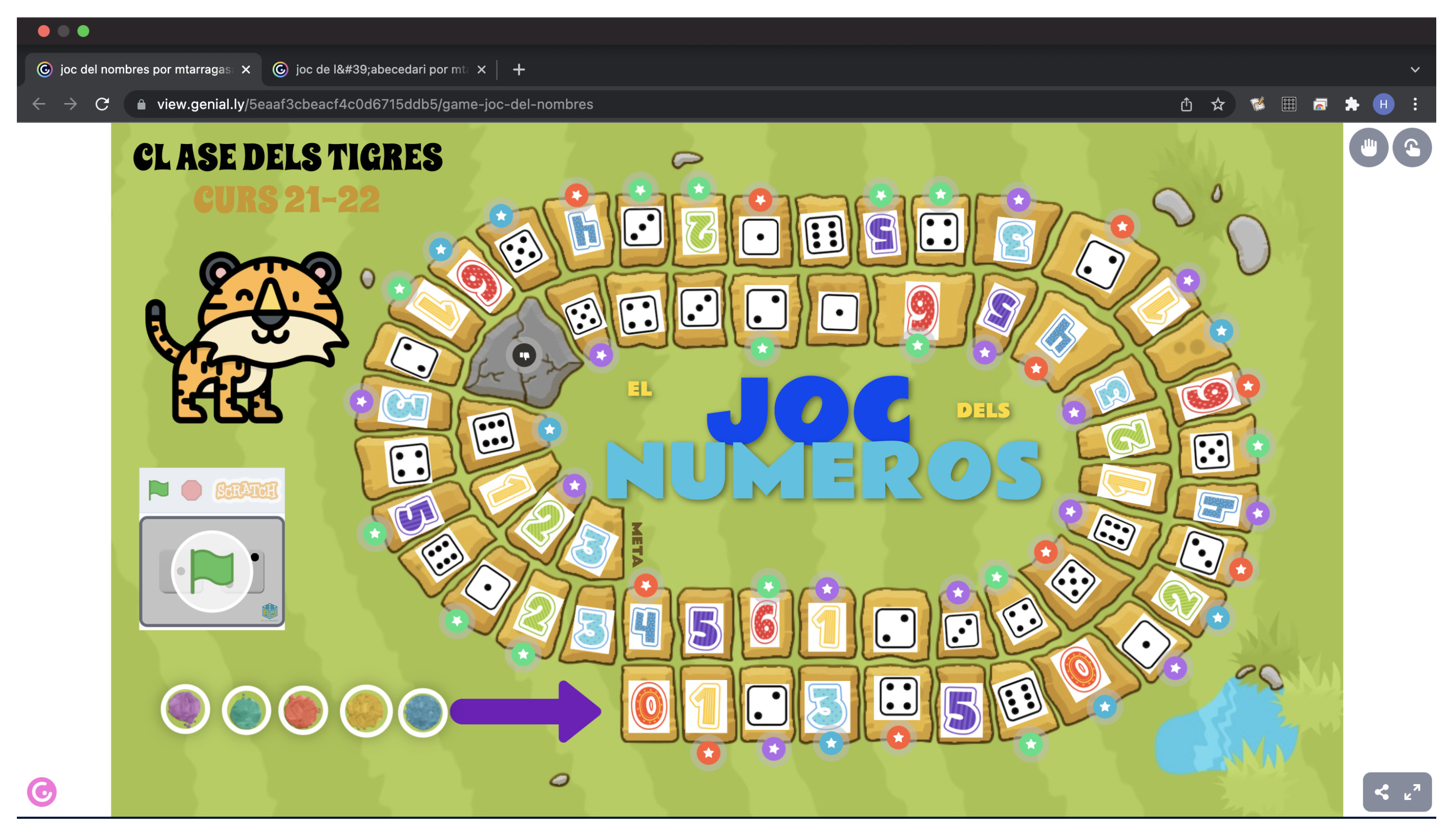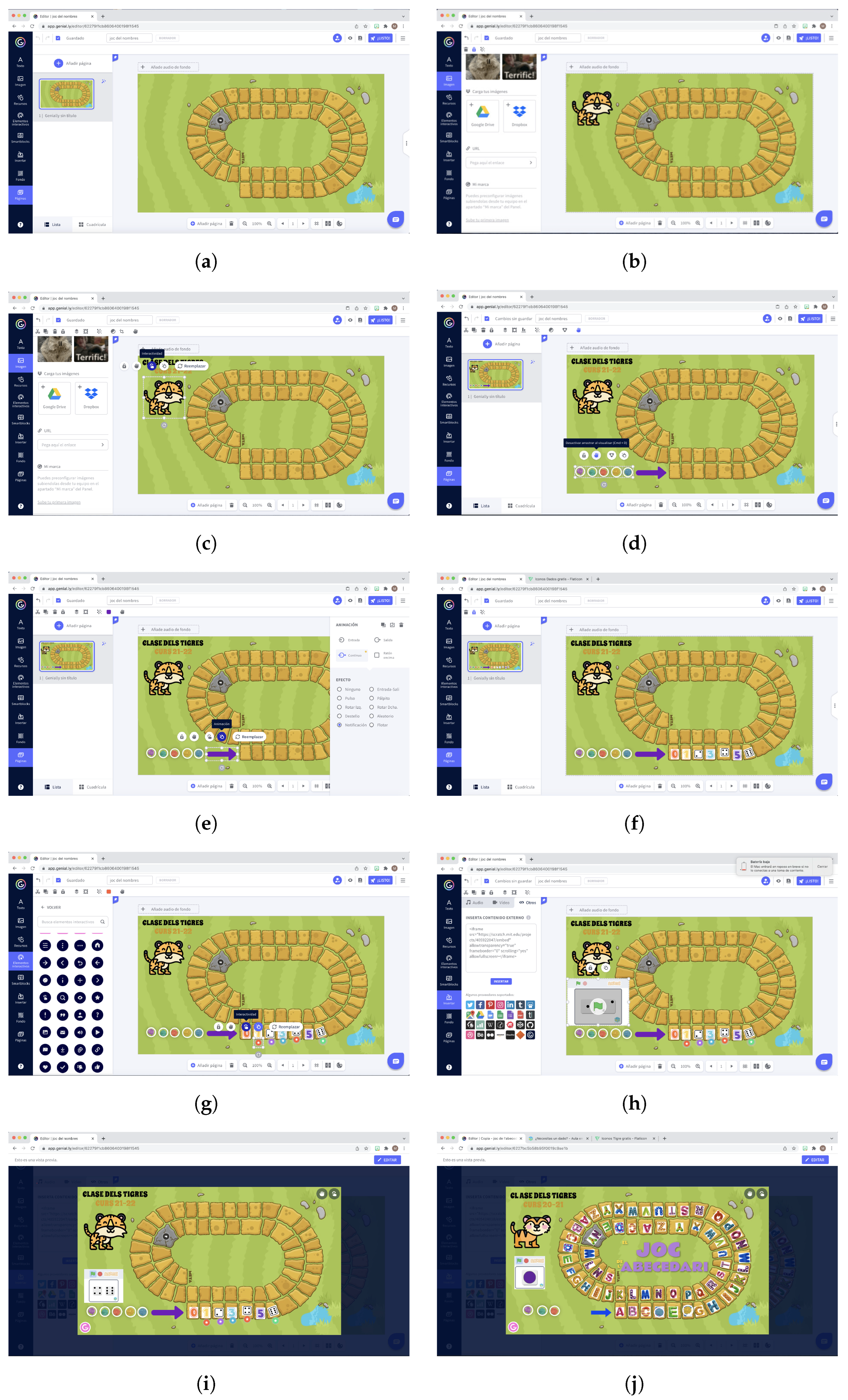Teacher-Developed Computer Games for Classroom and Online Reinforcement Learning for Early Childhood
Abstract
:1. Introduction
Educational Environment
2. Main Goals
3. Platforms and Tools Analysis
4. Game-Based Proposal
Examples of Developed Resources
5. Context
5.1. Learners and Game-Based Learning
5.2. Teachers and Computer Games Development
5.3. Resource Development
6. Discussion
7. Conclusions
Author Contributions
Funding
Institutional Review Board Statement
Informed Consent Statement
Data Availability Statement
Conflicts of Interest
References
- Moore, M.G. Learner Autonomy: The Second Dimension of Independent Learning. Proc. Converg. 1972, 5, 76–88. [Google Scholar]
- MacKenzie, N.; Postgate, R.; Scupham, J. Open Learning: Systems and Problems of Post-Secondary Education; UNESCO: Paris, France, 1976. [Google Scholar]
- Peters, O. Distance Teaching and Industrial Production* a Comparative Interpretation in Outline. In Distance Education: International Perspectives; Routledge: London, UK, 2020; pp. 95–113. [Google Scholar]
- Sutton, R.S.; Barto, A.G. Reinforcement Learning: An Introduction; MIT Press: London, UK, 2018. [Google Scholar]
- Alan, Ü. Distance education during the COVID-19 pandemic in Turkey: Identifying the needs of early childhood educators. Early Child. Educ. J. 2021, 49, 987–994. [Google Scholar] [CrossRef] [PubMed]
- Atiles, J.T.; Almodóvar, M.; Vargas, A.C.; Dias, M.J.A.; León, I.M.Z. International responses to COVID-19: Challenges faced by early childhood professionals. Eur. Early Child. Educ. Res. J. 2021, 29, 66–78. [Google Scholar] [CrossRef]
- Campos, M.M.; Vieira, L.F. COVID-19 and early childhood in Brazil: Impacts on children’s well-being, education and care. Eur. Early Child. Educ. Res. J. 2021, 29, 125–140. [Google Scholar] [CrossRef]
- Su, J.; Ng, D.T.K.; Yang, W.; Li, H. Global Trends in the Research on Early Childhood Education during the COVID-19 Pandemic: A Bibliometric Analysis. Educ. Sci. 2022, 12, 331. [Google Scholar] [CrossRef]
- Nikolopoulou, K. Online Education in Early Primary Years: Teachers’ Practices and Experiences during the COVID-19 Pandemic. Educ. Sci. 2022, 12, 76. [Google Scholar] [CrossRef]
- Prensky, M. The reformers are leaving our schools in the 20th century. Horizon 2011, 24, 1–18. [Google Scholar]
- Kim, B.; Park, H.; Baek, Y. Not just fun, but serious strategies: Using meta-cognitive strategies in game-based learning. Comput. Educ. 2009, 52, 800–810. [Google Scholar] [CrossRef]
- Papadakis, S.; Kalogiannakis, M.; Zaranis, N. Educational apps from the Android Google Play for Greek preschoolers: A systematic review. Comput. Educ. 2018, 116, 139–160. [Google Scholar] [CrossRef]
- Guernsey, L.; Levine, M.; Chiong, C.; Severns, M. Pioneering Literacy in the Digital Wild West: Empowering Parents and Educators; Technical Report; Routledge: London, UK, 2014. [Google Scholar]
- Lauricella, A.R.; Wartella, E.; Rideout, V.J. Young children’s screen time: The complex role of parent and child factors. J. Appl. Dev. Psychol. 2015, 36, 11–17. [Google Scholar] [CrossRef]
- Wartella, E. Educational apps: What we do and do not know. Psychol. Sci. Public Interest 2015, 16, 1–2. [Google Scholar] [CrossRef] [PubMed]
- Ebbeck, M.; Yim, H.Y.B.; Chan, Y.; Goh, M. Singaporean parents’ views of their young children’s access and use of technological devices. Early Child. Educ. J. 2016, 44, 127–134. [Google Scholar] [CrossRef]
- Parette, H.P.; Quesenberry, A.C.; Blum, C. Missing the boat with technology usage in early childhood settings: A 21st century view of developmentally appropriate practice. Early Child. Educ. J. 2010, 37, 335–343. [Google Scholar] [CrossRef]
- Judge, S.; Floyd, K.; Jeffs, T. Using Mobile Media Devices and Apps to Promote Young Children’s Learning. In Young Children and Families in the Information Age: Applications of Technology in Early Childhood; Springer: Dordrecht, The Netherlands, 2015; pp. 117–131. [Google Scholar] [CrossRef]
- Falloon, G. Young students using iPads: App design and content influences on their learning pathways. Comput. Educ. 2013, 68, 505–521. [Google Scholar] [CrossRef]
- Kucirkova, N. iPads in early education: Separating assumptions and evidence. Front. Psychol. 2014, 5, 715. [Google Scholar] [CrossRef] [PubMed] [Green Version]
- Tian, Y.; Nagappan, M.; Lo, D.; Hassan, A.E. What are the characteristics of high-rated apps? A case study on free Android Applications. In Proceedings of the 2015 IEEE International Conference on Software Maintenance and Evolution (ICSME), Bremen, Germany, 29 September–1 October 2015; pp. 301–310. [Google Scholar] [CrossRef]
- Vaala, S.; Ly, A.; Levine, M.H. Getting a Read on the App Stores: A Market Scan and Analysis of Children’s Literacy Apps. Full Report; Technical Report; ERIC: New York, NY, USA, 2015. [Google Scholar]
- Crescenzi, L.; Jewitt, C.; Price, S. The role of touch in preschool children’s learning using iPad versus paper interaction. Aust. J. Lang. Lit. 2014, 37, 86–95. [Google Scholar]
- Norman, D.A.; Spohrer, J.C. Learner-centered education. Commun. ACM 1996, 39, 24–27. [Google Scholar] [CrossRef]
- Watson, S.L.; Reigeluth, C.M. The learner-centered paradigm of education. Educ. Technol. 2008, 48, 42–48. [Google Scholar]
- Ruello, G.; Capodici, A. Learner-centered didactics: Towards a new model of experiential education. Atti Della Accad. Peloritana Dei-Pericolanti-Cl. Sci. Fis. Mat. Nat. 2021, 99, 24. [Google Scholar] [CrossRef]
- Yenawine, P. Visual Thinking Strategies for Preschool: Using Art to Enhance Literacy and Social Skills; ERIC: New York, NY, USA, 2018. [Google Scholar]
- Smith, R.S. Guidelines for Authors of Learning Objects; New Media Consortium: West Lake Hills, TX, USA, 2004. [Google Scholar]
- Hodgins, H.W. Into the Future A Vision Paper. Commission on Technology and Adult Learning. 2000. [Google Scholar]
- Choudhury, S.; Pattnaik, S. Emerging themes in e-learning: A review from the stakeholders’ perspective. Comput. Educ. 2020, 144, 103657. [Google Scholar] [CrossRef]
- Haavind, S.; Sistek-Chandler, C. The emergent role of the MOOC instructor: A qualitative study of trends toward improving future practice. Int. J. E-Learn. 2015, 14, 331–350. [Google Scholar]
- Ebben, M.; Murphy, J.S. Unpacking MOOC scholarly discourse: A review of nascent MOOC scholarship. Learn. Media Technol. 2014, 39, 328–345. [Google Scholar] [CrossRef]
- Kokotsaki, D.; Menzies, V.; Wiggins, A. Project-based learning: A review of the literature. Improv. Sch. 2016, 19, 267–277. [Google Scholar] [CrossRef]
- Diffily, D.; Sassman, C. Project-Based Learning with Young Children; Heinemann: London, UK, 2002. [Google Scholar]
- Corpus, J.H.; McClintic-Gilbert, M.S.; Hayenga, A.O. Within-year changes in children’s intrinsic and extrinsic motivational orientations: Contextual predictors and academic outcomes. Contemp. Educ. Psychol. 2009, 34, 154–166. [Google Scholar] [CrossRef]
- Juriševič, M.; Glažar, S.A.; Pučko, C.R.; Devetak, I. Intrinsic Motivation of Pre-service Primary School Teachers for Learning Chemistry in Relation to their Academic Achievement. Int. J. Sci. Educ. 2008, 30, 87–107. [Google Scholar] [CrossRef] [Green Version]
- Trajkovik, V.; Malinovski, T.; Vasileva-Stojanovska, T.; Vasileva, M. Traditional games in elementary school: Relationships of student’s personality traits, motivation and experience with learning outcomes. PLoS ONE 2018, 13, e0202172. [Google Scholar] [CrossRef]
- Kablan, Z. The Effect of Using Exercise-Based Computer Games during the Process of Learning on Academic Achievement among Education Majors. Educ. Sci. Theory Pract. 2010, 10, 351–364. [Google Scholar]
- Sayan, H. The effects of computer games on the achievement of basic mathematical skills. Educ. Res. Rev. 2015, 10, 2846–2853. [Google Scholar]
- McDonald Connor, C.; Son, S.H.; Hindman, A.H.; Morrison, F.J. Teacher qualifications, classroom practices, family characteristics, and preschool experience: Complex effects on first graders’ vocabulary and early reading outcomes. J. Sch. Psychol. 2005, 43, 343–375. [Google Scholar] [CrossRef]
- Brophy, J.E. Teacher Behavior and Student Achievement; Number 73; Institute for Research on Teaching, Michigan State University: East Lansing, MI, USA, 1984. [Google Scholar]
- Fraser, B.J. Use of classroom environment assessments in school psychology. Sch. Psychol. Int. 1987, 8, 205–219. [Google Scholar] [CrossRef]
- Stockard, J.; Mayberry, M. Effective Educational Environments; Corwin Press, Inc.: Newbury Park, CA, USA, 1992. [Google Scholar]
- Tsarava, K.; Moeller, K.; Román-González, M.; Golle, J.; Leifheit, L.; Butz, M.V.; Ninaus, M. A cognitive definition of computational thinking in primary education. Comput. Educ. 2022, 179, 104425. [Google Scholar] [CrossRef]





Disclaimer/Publisher’s Note: The statements, opinions and data contained in all publications are solely those of the individual author(s) and contributor(s) and not of MDPI and/or the editor(s). MDPI and/or the editor(s) disclaim responsibility for any injury to people or property resulting from any ideas, methods, instructions or products referred to in the content. |
© 2023 by the authors. Licensee MDPI, Basel, Switzerland. This article is an open access article distributed under the terms and conditions of the Creative Commons Attribution (CC BY) license (https://creativecommons.org/licenses/by/4.0/).
Share and Cite
Tárraga-Sánchez, M.d.l.Á.; Ballesteros-García, M.d.M.; Migallón, H. Teacher-Developed Computer Games for Classroom and Online Reinforcement Learning for Early Childhood. Educ. Sci. 2023, 13, 108. https://doi.org/10.3390/educsci13020108
Tárraga-Sánchez MdlÁ, Ballesteros-García MdM, Migallón H. Teacher-Developed Computer Games for Classroom and Online Reinforcement Learning for Early Childhood. Education Sciences. 2023; 13(2):108. https://doi.org/10.3390/educsci13020108
Chicago/Turabian StyleTárraga-Sánchez, María de los Ángeles, María del Mar Ballesteros-García, and Héctor Migallón. 2023. "Teacher-Developed Computer Games for Classroom and Online Reinforcement Learning for Early Childhood" Education Sciences 13, no. 2: 108. https://doi.org/10.3390/educsci13020108
APA StyleTárraga-Sánchez, M. d. l. Á., Ballesteros-García, M. d. M., & Migallón, H. (2023). Teacher-Developed Computer Games for Classroom and Online Reinforcement Learning for Early Childhood. Education Sciences, 13(2), 108. https://doi.org/10.3390/educsci13020108





